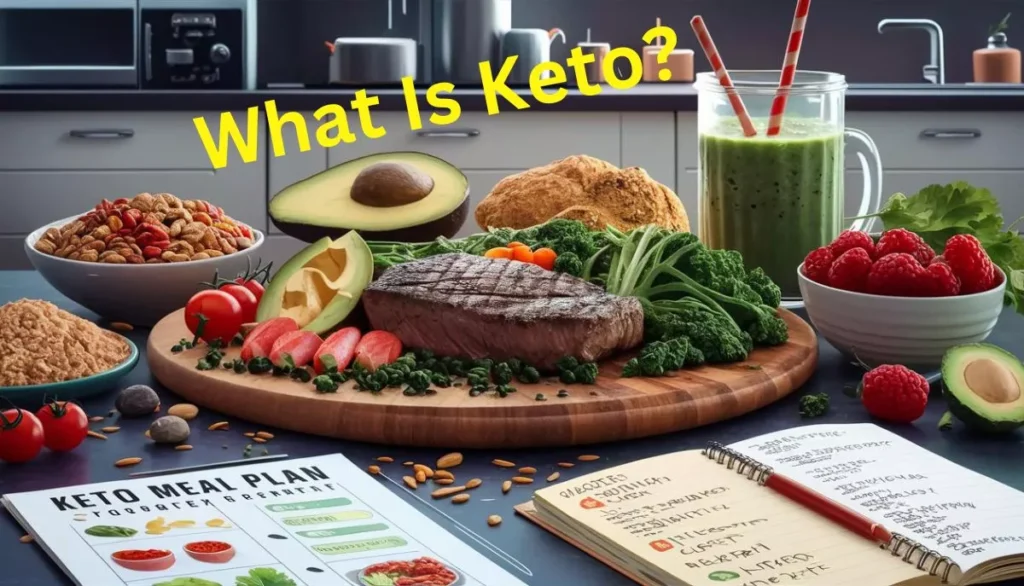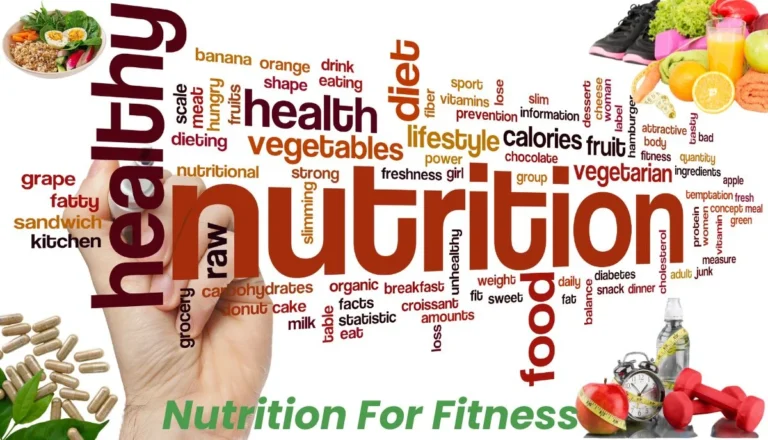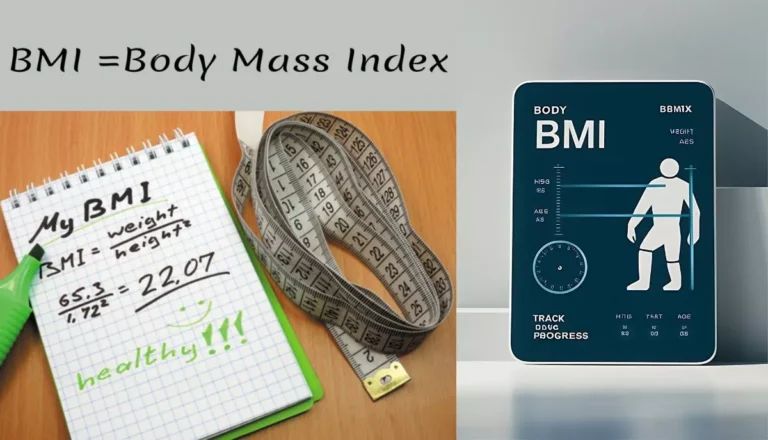Disclaimer: I have affiliate links in this post and receive a commission on any purchases you make at no cost to you. It’s one of the ways I support my site.
What is Keto? Reading on you will find out what it is, the benefits, and how to start. Dietary guidelines suggest that adults should get 45-65% of their calories from carbs. But the ketogenic diet, or *keto*, suggests getting 70-80% from healthy fats. This big change helps with weight loss and brings health benefits that interest researchers and people trying to eat better.
We’ll explore what keto means. We’ll cover its unique setup and benefits for weight loss and metabolic health. The keto diet cuts down on carbs, making the body use fat for energy instead. With more people trying keto, it’s key to know about its basics and perks for better health.
The keto diet is known for its unique nutrition approach. It focuses on eating a lot of fat, moderate protein, and very few carbs. This diet plan changes the body’s energy source from carbs to fat, leading to metabolic changes not seen in traditional diets.
Definition of the Ketogenic Diet
Also called the keto diet, it’s about eating 70% fat, 20% protein, and just 10% carbs. There are variations like the cyclical keto diet, which alternates between strict keto and higher-carb days. The targeted keto diet allows more carbs around workouts. Another version, the high-protein keto, has 60% fat, 35% protein, and 5% carbs. These ratios help with weight loss and health benefits.
How Keto Differs from Other Diets
When comparing keto vs low-fat diets, the differences are clear. People on the keto diet tend to lose more weight than those on a low-fat diet. For instance, a review found keto dieters lost about 2 pounds more on average.
Studies with type 2 diabetes patients also show keto leads to more fat loss than low-fat diets. The keto diet’s focus on low carbs improves blood sugar levels and may help heart health.
What is Keto? The Basics of the Ketogenic Diet
The ketogenic diet is a special way of eating. It focuses on eating very few carbs to make the body use fat for energy. This method uses certain foods to help the body work better.
Key Components of a Keto Diet
It’s important to know the main parts of a keto diet if you want to try it. Most of your daily calories come from fats, which are 60% to 80%. Foods like avocados and olive oil are great choices.
Proteins like fish and eggs also play a big role. But, you need to keep carbs very low, to about 20 to 50 grams a day. This helps your body use fat for energy. With these rules, you can still enjoy snacks like nuts, cheese, and meat jerky.
Types of Ketogenic Diets
There are different kinds of ketogenic diets for various needs and goals. The Standard Ketogenic Diet (SKD) has a lot of fat, about 70%, and very few carbs. Then there’s the Cyclical Ketogenic Diet (CKD) which lets you eat more carbs at times.
Athletes might like the Targeted Ketogenic Diet (TKD), which adds carbs before and after workouts. The High-Protein Ketogenic Diet (HPKD) changes the mix, with more protein and less carbs. Each type has its benefits but they all follow the main keto rules.
How Does the Keto Diet Work?
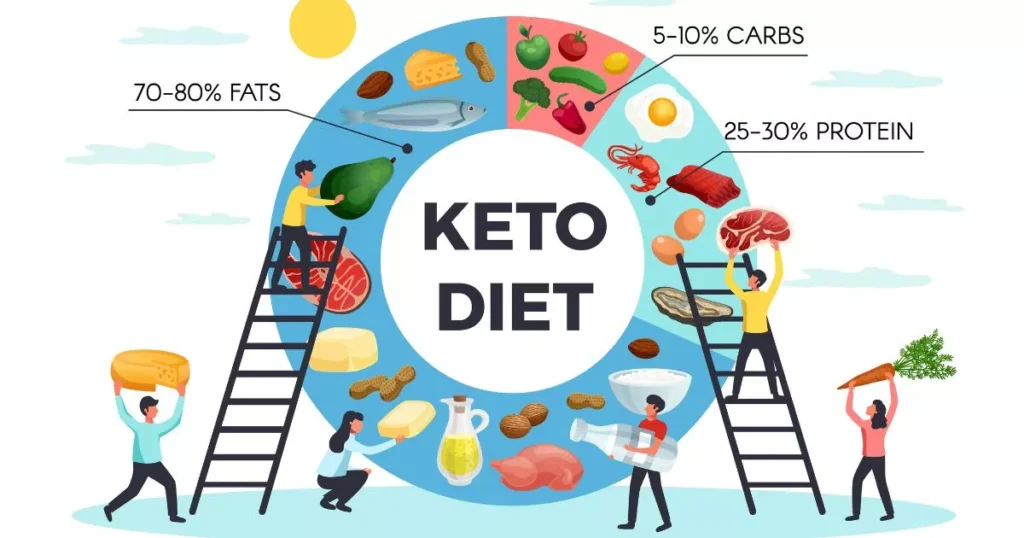
The ketogenic diet changes how your body uses energy by starting a metabolic shift called ketosis. This happens when you eat fewer carbs, making your body look for other energy sources. It then uses fat for fuel instead of glucose, which is key to the diet’s success.
The Process of Ketosis
When you eat less than 50 grams of carbs a day, your liver starts turning fat into ketone bodies. These ketone bodies become your body’s main energy source for your brain and muscles. This switch helps you burn more fat and can make you feel less hungry.
The Role of Ketone Bodies
Ketone bodies are important for keeping your energy up during ketosis. They come in three types: acetoacetate, beta-hydroxybutyrate, and acetone. These help you get energy from fat when you don’t have many carbs. This diet can make you more focused and help keep your blood sugar stable.
Benefits of Keto for Weight Loss
The ketogenic diet helps people lose weight by focusing on high fat and low carbs. This diet makes your body burn fat and helps control your appetite. These benefits make keto a popular choice for many.
How Keto Promotes Fat Burning
Keto promotes fat burning as its main benefit for weight loss. Studies show that people on keto diets lose more weight than those on low-fat diets. For example, a 2013 study found that keto dieters lost about 2 pounds more than low-fat dieters in a year.
This fat-burning is linked to lower insulin levels and less hunger. This helps people keep up with their weight loss goals.
Appetite Control and Food Choices
Keto also helps control your appetite. It affects hormones that manage hunger, helping you feel naturally full. By choosing healthier foods and eating fewer calories, many people find it easier to stick to their weight loss goals.
Long-term Weight Loss Results
Keto can lead to lasting weight loss and better metabolic health. After six months, people on keto lost about 5 pounds more than those on low-fat diets. More research is needed, but early results look promising for long-term success.
Health Benefits Beyond Weight Loss

The keto diet has many health perks that go beyond just losing weight. As studies go on, we see more benefits for our health. People on the keto diet might see better heart health, improve how their bodies handle insulin, and help with neurological issues.
Keto and Heart Health
One big plus of the keto diet is its effect on heart health. Studies show that those on a keto diet often have less bad cholesterol and triglycerides. At the same time, they have more good cholesterol. This makes their heart healthier and lowers the risk of heart disease.
Potential Effects on Diabetes
Keto and diabetes have a strong connection. Research finds that a keto lifestyle can make insulin work better and control blood sugar. Many people in keto studies needed less diabetes medicine and lost weight, which helped their health a lot.
Keto’s Influence on Neurological Disorders
Keto has a long history of treating epilepsy. The classic keto diet has been used for years to help manage seizures. New studies suggest it might also protect against Alzheimer’s disease. This shows keto’s big role in brain health, not just weight loss.
| Health Aspect | Benefit of Keto | Supporting Evidence |
|---|---|---|
| Heart Health | Reduces bad cholesterol, increases good cholesterol | Improved lipid profiles in research participants |
| Diabetes Management | Enhances insulin sensitivity, reduces blood sugar | Participants reported reducing or discontinuing medications |
| Neurological Disorders | Potentially reduces seizure activity | Significant improvements in epilepsy and other disorders |
Creating a Keto Meal Plan
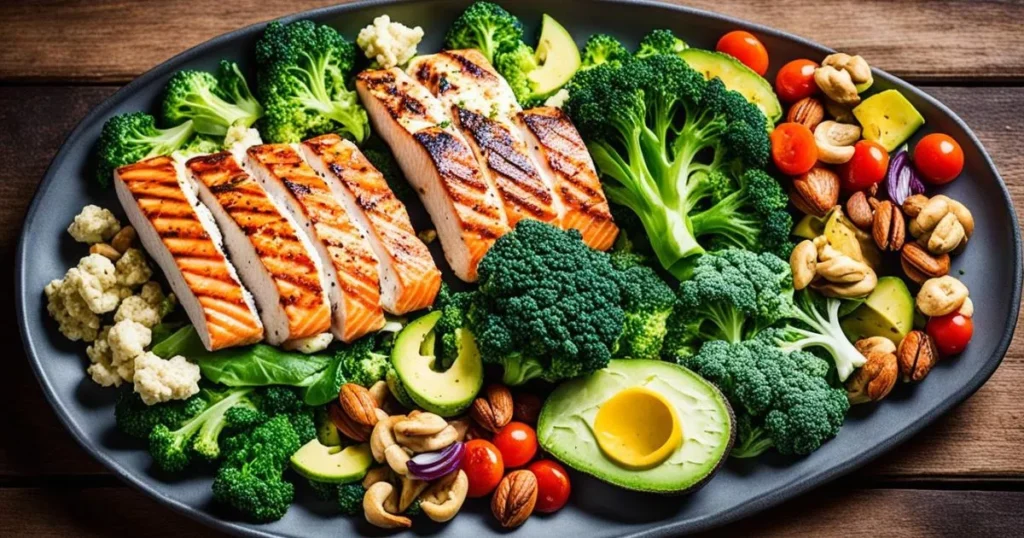
Making a Keto meal Plan means picking foods that keep you in ketosis and boost your health. It’s all about choosing the right foods and avoiding high-carb ones. This helps with weight loss, keeps energy up, and meets nutritional needs.
Essential Keto Foods to Include
Make sure to add these key keto foods to your meals:
- – Fatty fish, such as salmon and mackerel
- – Avocados and avocado oil
- – Cheese, especially hard cheeses like cheddar
- – Nuts and seeds, including almonds and macadamia nuts
- – Non-starchy vegetables like spinach, zucchini, and cauliflower
- – Meat options such as chicken thighs and ground beef
- – Eggs as a versatile protein source
- – Heavy cream for cooking and coffee
A good keto meal plan should have about 70-75% fats, 20-25% protein, and only 5-10% carbohydrates. It’s key to keep carbs under 20-50 grams a day to stay in ketosis.
Foods to Avoid on the Keto Diet
For the best results, limit or avoid these foods:
- – Bread and pasta
- – Sweetened drinks and sugary snacks
- – Starchy vegetables like potatoes and corn
- – Most fruits, except for berries in moderation
- – Grains and legumes
- – Certain alcoholic beverages high in carbs
Staying away from these foods helps you stay in ketosis and burn fat better. Drinking water, unsweetened coffee, and green tea is good for hydration without adding carbs.
A good keto meal plan focuses on the right foods and tells you which ones to skip. By doing this, anyone can enjoy the health perks of the ketogenic diet.
How to Start Keto Safely

Starting a keto diet needs careful planning to avoid common issues. It’s key for anyone, especially those with health conditions. Talking to healthcare pros can give you tailored advice, helping you meet your health needs and handle risks.
Consulting Healthcare Professionals
It’s smart to talk to healthcare pros before starting the keto diet, especially if you have health issues or take meds. They can suggest diet changes and watch your progress. Their advice helps make the switch safer and less stressful.
Managing the Transition to Keto
Switching to a keto lifestyle can be tough. Many feel “keto flu” symptoms from changing what you eat. To ease this, slowly cut down on carbs, drink plenty of water, and get enough nutrients. This helps your body adjust to using fat for energy.
Potential Side Effects and Solutions
Knowing about keto side effects is key when starting. Fatigue, dizziness, and stomach problems are common. To fight these, up your electrolyte game with sodium, potassium, and magnesium. Regular health check-ins can also help you tackle any issues.
| Aspect | Considerations |
|---|---|
| Consultation | Seek advice from healthcare professionals before starting. |
| Transition | Introduce the diet gradually to minimize “keto flu.” |
| Hydration | Stay hydrated to mitigate potential side effects. |
| Electrolytes | Increase sodium, potassium, and magnesium intake. |
| Monitoring | Regular check-ins with healthcare professionals can be beneficial. |
Delicious Keto Recipes to Try

Exploring keto recipes can make meals fun and fulfilling. These recipes are perfect for any time of day, from keto breakfast to snacks. They focus on flavor and are low in carbs, making sticking to a keto diet easy.
Breakfast Ideas
Begin your day with tasty keto breakfast options. Try cheesesteak lettuce wraps or keto-fried chicken for a protein-packed start. For something lighter, enjoy low-carb smoothies or eggs in dishes like Cacio E Pepe egg noodles or with veggies for extra nutrition.
Lunch and Dinner Options
For a filling keto lunch or dinner, consider chicken alfredo spaghetti squash or feta & herb-crusted salmon. Beef stroganoff and garlicky Greek chicken are also great choices. Don’t forget about Asian-inspired dishes like keto ramen and cauliflower fried rice. These meals often use chicken, beef, and veggies, cooked by sautéing or grilling.
Keto Snacks and Desserts
Keto snacks don’t have to be boring. Enjoy tasty treats like keto cookies and fat bombs that satisfy your sweet tooth without ruining your diet. Ingredients like almond flour and pork rinds help create delicious snacks. Each recipe makes 4-6 servings, ideal for meal prep or sharing.
Conclusion
The ketogenic diet has been around since the 1920s and is known for its health benefits. It helps people lose weight by making the body burn fat. This diet helps manage blood sugar and insulin sensitivity. It also aids diabetes and metabolic syndrome.
Switching to the keto diet changes how the body gets energy. It uses ketones instead of glucose, which can make you think clearer and feel more energetic. This diet can also reduce inflammation, which is important for fighting chronic diseases. It’s a great way to lose weight and improve your overall health.
When starting the keto diet, it’s important to think about your health goals. Talking to a healthcare provider can help you make the most of it. The keto diet can help with weight loss, better blood sugar control, and improved mental focus. It’s a strong choice for those looking to improve their health.
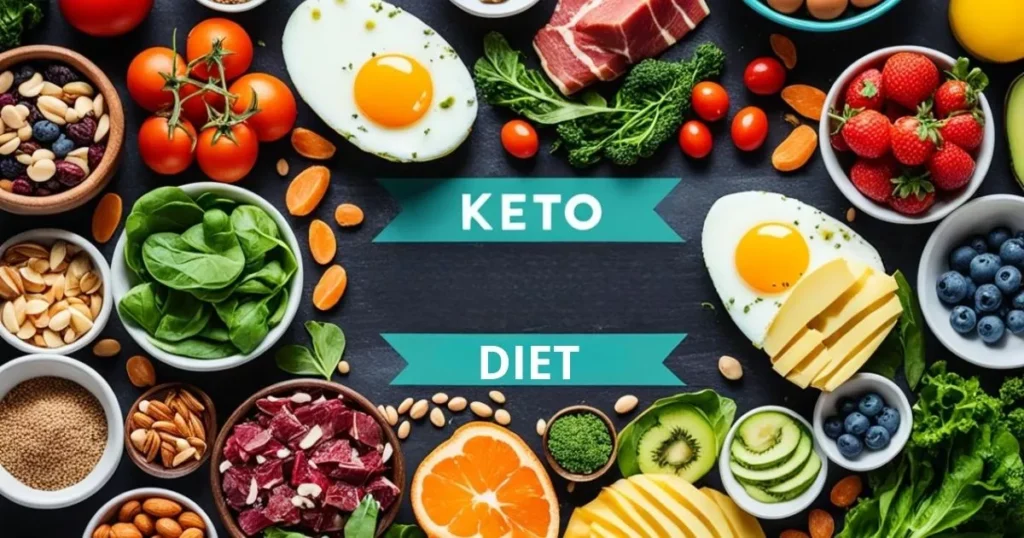
Frequently Asked Questions
Q: What is the keto diet and how does it work?
A: The keto diet, or ketogenic diet, is a low-carb, high-fat diet. It aims to shift the body’s energy source from carbs to fats, producing molecules called ketones. Ketosis is a metabolic state where the body burns fat for fuel instead of glucose.
Q: What are the benefits of following a keto diet?
A: Following a ketogenic diet may help you lose weight, improve mental clarity, and increase energy levels. The diet can lead to better blood sugar control, making it beneficial for people with type 2 diabetes.
Q: What foods can you eat on the keto diet?
A: On the keto diet, it’s important to eat foods that are high in fat and low in carbs. Foods you can eat include meat, fish, eggs, butter, oils, cheese, avocados, nuts, and low-carb vegetables. Avoid foods that are high in carbs like bread, pasta, and sugars.
Q: How quickly can you lose weight on the keto diet?
A: Weight loss can vary. Yet, many people report the significant loss within a few weeks of starting a ketogenic diet. Consistency and adherence to the diet play a crucial role in how quickly you lose weight.
Q: Is the keto diet suitable for everyone?
A: The keto diet may help many, but it is restrictive. It may not suit everyone, especially those with certain medical conditions. Always consult with a healthcare provider before starting a ketogenic diet.
Q: What are some common mistakes to avoid when starting a ketogenic diet?
A: Common mistakes include: not eating enough fat, hidden carbs, and neglecting to reintroduce electrolytes. Also, many don’t drink enough water. It’s important to eat a well-formulated ketogenic diet to avoid issues.
Q: How do you know when you are in ketosis?
A: You can tell you’re in ketosis by symptoms such as increased energy, reduced hunger, and occasional bad breath. Additionally, you can measure ketones in your blood, urine, or breath using specialized testing kits.
Q: Can you exercise while following the keto diet?
A: Yes, you can exercise while following the keto diet. You may see a dip in performance at first as your body adjusts. But, you should regain and possibly improve your performance over time.
Q: Are there any long-term risks associated with the keto diet?
A: Long-term risks of a ketogenic diet may include nutrient deficiencies, liver problems, and kidney stones. It’s important to follow the keto diet under medical supervision to mitigate these risks.
Q: How does the keto diet compare to the Atkins diet?
A: Both the keto and Atkins diets are low-carbohydrate diets. The Atkins diet starts with a very low-carb phase. It then gradually increases carb intake. The keto diet keeps a low-carb, high-fat intake to maintain ketosis.

